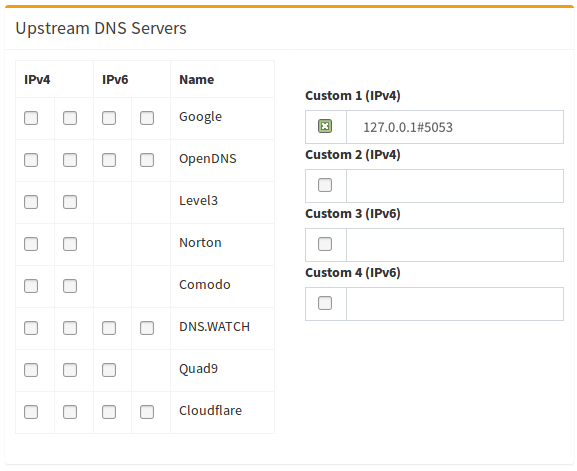Configuring DNS-Over-HTTPS on Pi-hole
Why use DNS-Over-HTTPS?¶
DNS-Over-HTTPS is a protocol for performing DNS lookups via the same protocol you use to browse the web securely: HTTPS.
With standard DNS, requests are sent in plain-text, with no method to detect tampering or misbehavior. This means that not only can a malicious actor look at all the DNS requests you are making (and therefore what websites you are visiting), they can also tamper with the response and redirect your device to resources in their control (such as a fake login page for internet banking).
DNS-Over-HTTPS prevents this by using standard HTTPS requests to retrieve DNS information. This means that the connection from the device to the DNS server is secure and can not easily be snooped, monitored, tampered with or blocked. It is worth noting, however, that the upstream DNS-Over-HTTPS provider will still have this ability.
Configuring DNS-Over-HTTPS¶
Along with releasing their DNS service 1.1.1.1, Cloudflare implemented DNS-Over-HTTPS proxy functionality into one of their tools: cloudflared.
In the following sections, we will be covering how to install and configure this tool on Pi-hole.
Installing cloudflared¶
The installation is fairly straightforward, however, be aware of what architecture you are installing on (amd64 or arm).
AMD64 architecture (most devices)¶
Download the installer package, then use apt-get to install the package along with any dependencies. Proceed to run the binary with the -v flag to check it is all working:
# For Debian/Ubuntu
wget https://bin.equinox.io/c/VdrWdbjqyF/cloudflared-stable-linux-amd64.deb
sudo apt-get install ./cloudflared-stable-linux-amd64.deb
cloudflared -v
# For CentOS/RHEL/Fedora
wget https://bin.equinox.io/c/VdrWdbjqyF/cloudflared-stable-linux-amd64.rpm
sudo yum install ./cloudflared-stable-linux-amd64.rpm
cloudflared -v
Note: Binaries for other operating systems can be found here: https://developers.cloudflare.com/argo-tunnel/downloads/
ARM architecture (Raspberry Pi)¶
Here we are downloading the precompiled binary and copying it to the /usr/local/bin/ directory to allow execution by the cloudflared user. Proceed to run the binary with the -v flag to check it is all working:
wget https://bin.equinox.io/c/VdrWdbjqyF/cloudflared-stable-linux-arm.tgz
tar -xvzf cloudflared-stable-linux-arm.tgz
sudo cp ./cloudflared /usr/local/bin
sudo chmod +x /usr/local/bin/cloudflared
cloudflared -v
Configuring cloudflared to run on startup¶
Manual way¶
Create a cloudflared user to run the daemon:
sudo useradd -s /usr/sbin/nologin -r -M cloudflared
Proceed to create a configuration file for cloudflared by copying the following in to /etc/default/cloudflared. This file contains the command-line options that get passed to cloudflared on startup:
# Commandline args for cloudflared
CLOUDFLARED_OPTS=--port 5053 --upstream https://1.1.1.1/dns-query --upstream https://1.0.0.1/dns-query
Update the permissions for the configuration file and cloudflared binary to allow access for the cloudflared user:
sudo chown cloudflared:cloudflared /etc/default/cloudflared
sudo chown cloudflared:cloudflared /usr/local/bin/cloudflared
Then create the systemd script by copying the following into /etc/systemd/system/cloudflared.service. This will control the running of the service and allow it to run on startup:
sudo nano /etc/systemd/system/cloudflared.service
[Unit]
Description=cloudflared DNS over HTTPS proxy
After=syslog.target network-online.target
[Service]
Type=simple
User=cloudflared
EnvironmentFile=/etc/default/cloudflared
ExecStart=/usr/local/bin/cloudflared proxy-dns $CLOUDFLARED_OPTS
Restart=on-failure
RestartSec=10
KillMode=process
[Install]
WantedBy=multi-user.target
Enable the systemd service to run on startup, then start the service and check its status:
sudo systemctl enable cloudflared
sudo systemctl start cloudflared
sudo systemctl status cloudflared
Automatic way¶
Warning
Keep in mind that this will install cloudflared as root.
Proceed to create a configuration file for cloudflared in /etc/cloudflared named config.yml:
sudo mkdir /etc/cloudflared/
sudo nano /etc/cloudflared/config.yml
Copy the following configuration:
proxy-dns: true
proxy-dns-port: 5053
proxy-dns-upstream:
- https://1.1.1.1/dns-query
- https://1.0.0.1/dns-query
Now install the service via cloudflared's service command:
sudo cloudflared service install
Start the systemd service and check its status:
sudo systemctl start cloudflared
sudo systemctl status cloudflared
Now test that it is working! Run the following dig command, a response should be returned similar to the one below:
pi@raspberrypi:~ $ dig @127.0.0.1 -p 5053 google.com
; <<>> DiG 9.11.5-P4-5.1-Raspbian <<>> @127.0.0.1 -p 5053 google.com
; (1 server found)
;; global options: +cmd
;; Got answer:
;; ->>HEADER<<- opcode: QUERY, status: NOERROR, id: 12157
;; flags: qr rd ra; QUERY: 1, ANSWER: 1, AUTHORITY: 0, ADDITIONAL: 1
;; OPT PSEUDOSECTION:
; EDNS: version: 0, flags:; udp: 4096
; COOKIE: 22179adb227cd67b (echoed)
;; QUESTION SECTION:
;google.com. IN A
;; ANSWER SECTION:
google.com. 191 IN A 172.217.22.14
;; Query time: 0 msec
;; SERVER: 127.0.0.1#5053(127.0.0.1)
;; WHEN: Wed Dec 04 09:29:50 EET 2019
;; MSG SIZE rcvd: 77
Configuring Pi-hole¶
Finally, configure Pi-hole to use the local cloudflared service as the upstream DNS server by specifying 127.0.0.1#5053 as the Custom DNS (IPv4):

(don't forget to hit Return or click on Save)
Updating cloudflared¶
Manual way¶
wget https://bin.equinox.io/c/VdrWdbjqyF/cloudflared-stable-linux-arm.tgz
tar -xvzf cloudflared-stable-linux-arm.tgz
sudo systemctl stop cloudflared
sudo cp ./cloudflared /usr/local/bin
sudo chmod +x /usr/local/bin/cloudflared
sudo systemctl start cloudflared
cloudflared -v
sudo systemctl status cloudflared
Automatic way¶
sudo cloudflared update
sudo systemctl restart cloudflared
Uninstalling cloudflared¶
If installed the manual way¶
Courtesy of https://discourse.pi-hole.net/t/uninstall-cloudflare/21459/3
sudo systemctl stop cloudflared
sudo systemctl disable cloudflared
sudo systemctl daemon-reload
sudo deluser cloudflared
sudo rm /etc/default/cloudflared
sudo rm /etc/systemd/system/cloudflared.service
sudo rm /usr/local/bin/cloudflared
If installed with cloudflare service install¶
sudo cloudflared service uninstall
sudo systemctl daemon-reload
After the above, don't forget to change the DNS back to something else in Pi-hole's DNS settings!
-
Based on this guide by Ben Dews | bendews.com ↩